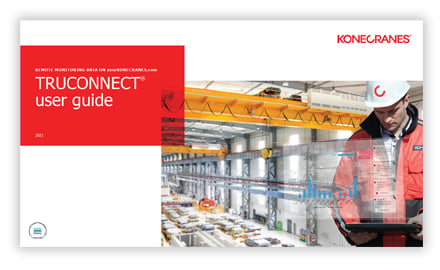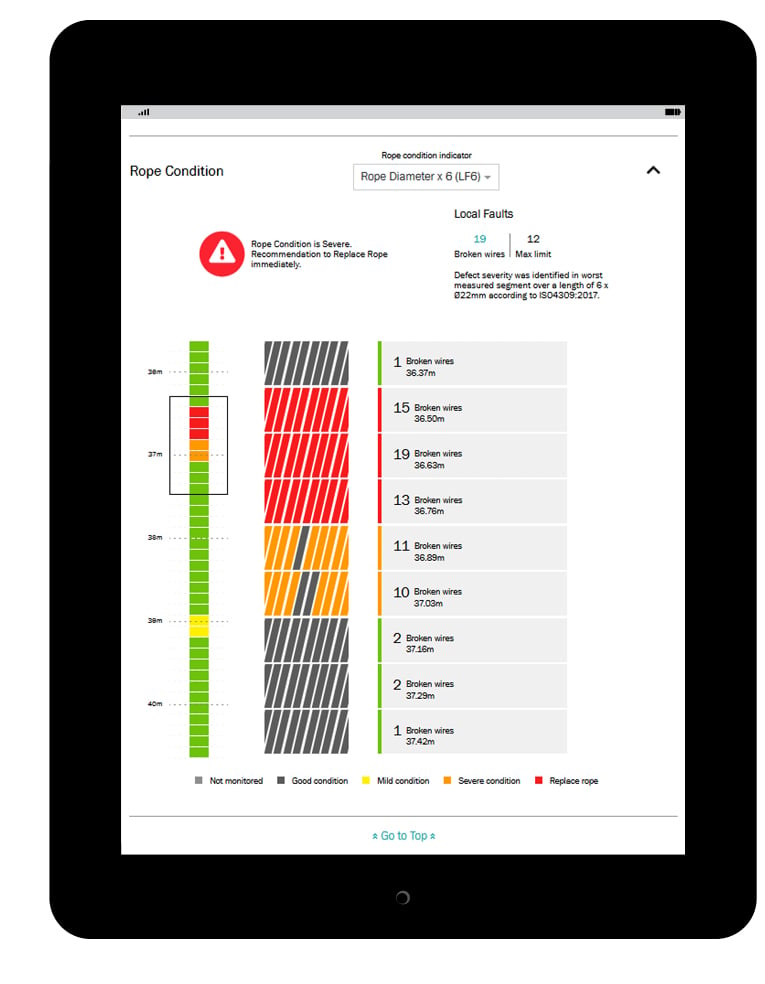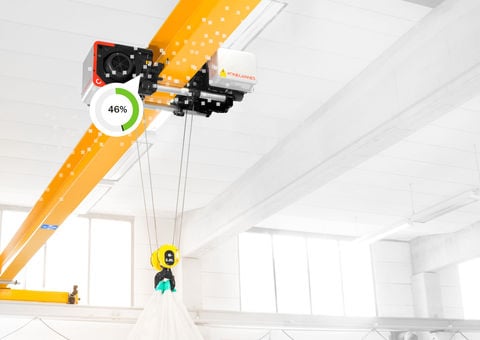Make informed maintenance decisions with TRUCONNECT data
 TRUCONNECT Remote Monitoring data is aggregated at yourKONECRANES.com along with your inspection and maintenance data giving you a comprehensive view of equipment maintenance needs and performance.
TRUCONNECT Remote Monitoring data is aggregated at yourKONECRANES.com along with your inspection and maintenance data giving you a comprehensive view of equipment maintenance needs and performance.
Analyzing and identifying anomalies, patterns and trends in TRUCONNECT data helps you make informed maintenance decisions and prioritize actions.
TRUCONNECT Remote Monitoring
 Condition monitoring shows the current condition of the components, any risks related to safety and production, and the estimated remaining service life based on the usage history. Condition monitoring can also be used to check the component replacement frequency, which provides a clear indication of upcoming maintenance needs and how changes in the operator's actions affect the service life of components. This information can be used to plan and schedule preventive maintenance in order to improve safety and reduce unplanned downtime.
Condition monitoring shows the current condition of the components, any risks related to safety and production, and the estimated remaining service life based on the usage history. Condition monitoring can also be used to check the component replacement frequency, which provides a clear indication of upcoming maintenance needs and how changes in the operator's actions affect the service life of components. This information can be used to plan and schedule preventive maintenance in order to improve safety and reduce unplanned downtime.
The Alert Pareto analysis displays and ranks the most important causes of alerts related to the safety and usability of the crane. Alerts are ranked cumulatively from the most frequent to the least frequent alert. A cumulative trend depicts the proportion of the total alerts of each specific cause relative to the total number of alerts. A 20/80 rule can be formed to show the 20% of the causes that are responsible for 80% of the problems. In other words, the 20% of the most common causes are responsible for 80% of problems related to safety and/or production downtime.
Operating Statistics show how different crane operating patterns affect the safe operation and condition of the crane and the service life of critical components. Operating patterns can significantly influence the service life and safety of individual components. You can also see usage rate differences between different hoists and the subsequent differences in their remaining service life. This information is designed to promote appropriate operation in order to achieve optimal results in terms of the safety, service life and maintenance costs of the crane investment.
TRUCONNECT Brake Monitoring

Brake Monitoring measures opening current and indirectly shows the status of air gap and friction material wear. As the air gap of the brake increases, the value decreases toward 0%. If the value is under 5%, there is very probable risk that the brake will not open. If the brake does not open you can be faced with sudden brake failure that can result in load drop and severe danger to everyone in the vicinity of the crane.Brake Monitoring provides safety alerts so you can be alerted to brake issues such as condition warnings and failures by text or email. Alerts are shown in the Alerts section.
An increase in air gap and moderate wear in the friction material of the brake indicate a need for corrective action.
You’ll want to closely monitor the condition of the brake and brake friction materials. You can also have the brake mechanics and electrics inspected and an inspection and adjustment of the air gap of the brake.
TRUCONNECT Wire Rope Monitoring
 With TRUCONNECT Wire Rope Monitoring, sensors gather data while the crane is in normal operation to allow for continuous monitoring of the most wearing sections of the wire rope. Wire Rope Monitoring data shows a trend view which indicates the progress of rope defects over the selected time frame. Warning and discard limits are shown so you can plan for replacements or there is an immediate need to replace the wire rope. Safety alerts can be sent by email when a Wire Rope Monitoring safety issue appears such as a pre-warning for a need to replace the wire rope or a warning that the wire rope needs to be replaced immediately.
With TRUCONNECT Wire Rope Monitoring, sensors gather data while the crane is in normal operation to allow for continuous monitoring of the most wearing sections of the wire rope. Wire Rope Monitoring data shows a trend view which indicates the progress of rope defects over the selected time frame. Warning and discard limits are shown so you can plan for replacements or there is an immediate need to replace the wire rope. Safety alerts can be sent by email when a Wire Rope Monitoring safety issue appears such as a pre-warning for a need to replace the wire rope or a warning that the wire rope needs to be replaced immediately.
Continuous hoist operation, especially when the same lifting height is used repeatedly, shock loads and overloads, repeated rope bends through rope sheaves during hoist operation with burden, and rope surface damage for an external reason such as a collision or corrosion can indicate that the number of broken wires is increasing which can cause sudden rope failure. Replace the wire rope according to the TRUCONNECT alerts.


 Condition monitoring shows the current condition of the components, any risks related to safety and production, and the estimated remaining service life based on the usage history. Condition monitoring can also be used to check the component replacement frequency, which provides a clear indication of upcoming maintenance needs and how changes in the operator's actions affect the service life of components. This information can be used to plan and schedule preventive maintenance in order to improve safety and reduce unplanned downtime.
Condition monitoring shows the current condition of the components, any risks related to safety and production, and the estimated remaining service life based on the usage history. Condition monitoring can also be used to check the component replacement frequency, which provides a clear indication of upcoming maintenance needs and how changes in the operator's actions affect the service life of components. This information can be used to plan and schedule preventive maintenance in order to improve safety and reduce unplanned downtime. 
 With TRUCONNECT Wire Rope Monitoring, sensors gather data while the crane is in normal operation to allow for continuous monitoring of the most wearing sections of the wire rope. Wire Rope Monitoring data shows a trend view which indicates the progress of rope defects over the selected time frame. Warning and discard limits are shown so you can plan for replacements or there is an immediate need to replace the wire rope. Safety alerts can be sent by email when a Wire Rope Monitoring safety issue appears such as a pre-warning for a need to replace the wire rope or a warning that the wire rope needs to be replaced immediately.
With TRUCONNECT Wire Rope Monitoring, sensors gather data while the crane is in normal operation to allow for continuous monitoring of the most wearing sections of the wire rope. Wire Rope Monitoring data shows a trend view which indicates the progress of rope defects over the selected time frame. Warning and discard limits are shown so you can plan for replacements or there is an immediate need to replace the wire rope. Safety alerts can be sent by email when a Wire Rope Monitoring safety issue appears such as a pre-warning for a need to replace the wire rope or a warning that the wire rope needs to be replaced immediately.


